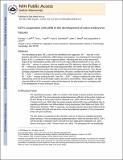| dc.contributor.author | Lee, Eunice Y. | |
| dc.contributor.author | Yuan, Tina L. | |
| dc.contributor.author | Danielian, Paul S. | |
| dc.contributor.author | West, Julie C. | |
| dc.contributor.author | Lees, Jacqueline | |
| dc.date.accessioned | 2012-10-18T16:47:05Z | |
| dc.date.available | 2012-10-18T16:47:05Z | |
| dc.date.issued | 2009-05 | |
| dc.date.submitted | 2009-04 | |
| dc.identifier.issn | 0012-1606 | |
| dc.identifier.issn | 1095-564X | |
| dc.identifier.uri | http://hdl.handle.net/1721.1/74082 | |
| dc.description | August 1, 2010 | en_US |
| dc.description.abstract | The retinoblastoma gene, RB-1, was the first identified tumor suppressor. Rb[superscript −/−] mice die in mid-gestation with defects in proliferation, differentiation and apoptosis. The activating E2F transcription factors, E2F1–3, contribute to these embryonic defects, indicating that they are key downstream targets of the retinoblastoma protein, pRB. E2F4 is the major pRB-associated E2F in vivo, yet its role in Rb[superscript −/−] embryos is unknown. Here we establish that E2f4 deficiency reduced the lifespan of Rb[superscript −/−] embryos by exacerbating the Rb mutant placental defect. We further show that this reflects the accumulation of trophectoderm-like cells in both Rb and Rb;E2f4 mutant placentas. Thus, Rb and E2f4 play cooperative roles in placental development. We used a conditional mouse model to allow Rb[superscript −/−];E2f4[superscript −/−] embryos to develop in the presence of Rb wild-type placentas. Under these conditions, Rb[superscript −/−];E2f4[superscript −/−] mutants survived to birth. These Rb[superscript −/−];E2f4[superscript −/−] embryos exhibited all of the defects characteristic of the Rb and E2f4 single mutants and had no novel defects. Taken together, our data show that pRB and E2F4 cooperate in placental development, but play largely non-overlapping roles in the development of many embryonic tissues. | en_US |
| dc.description.sponsorship | David H. Koch Institute for Integrative Cancer Research at MIT. Pearl Staller Graduate Student Fund | en_US |
| dc.description.sponsorship | National Institutes of Health (U.S.) (Grant GM53204) | en_US |
| dc.description.sponsorship | National Institutes of Health (U.S.) (Grant CA121921) | en_US |
| dc.language.iso | en_US | |
| dc.publisher | Elsevier | en_US |
| dc.relation.isversionof | http://dx.doi.org/10.1016/j.ydbio.2009.05.541 | en_US |
| dc.rights | Creative Commons Attribution-Noncommercial-Share Alike 3.0 | en_US |
| dc.rights.uri | http://creativecommons.org/licenses/by-nc-sa/3.0/ | en_US |
| dc.source | PMC | en_US |
| dc.title | E2F4 cooperates with pRB in the development of extra-embryonic tissues | en_US |
| dc.type | Article | en_US |
| dc.identifier.citation | Lee, Eunice Y. et al. “E2F4 Cooperates with pRB in the Development of Extra-embryonic Tissues.” Developmental Biology 332.1 (2009): 104–115. | en_US |
| dc.contributor.department | Massachusetts Institute of Technology. Department of Biology | en_US |
| dc.contributor.department | Koch Institute for Integrative Cancer Research at MIT | en_US |
| dc.contributor.mitauthor | Lee, Eunice Y. | |
| dc.contributor.mitauthor | Yuan, Tina L. | |
| dc.contributor.mitauthor | Danielian, Paul S. | |
| dc.contributor.mitauthor | West, Julie C. | |
| dc.contributor.mitauthor | Lees, Jacqueline | |
| dc.relation.journal | Developmental Biology | en_US |
| dc.eprint.version | Author's final manuscript | en_US |
| dc.type.uri | http://purl.org/eprint/type/JournalArticle | en_US |
| eprint.status | http://purl.org/eprint/status/PeerReviewed | en_US |
| dspace.orderedauthors | Lee, Eunice Y.; Yuan, Tina L.; Danielian, Paul S.; West, Julie C.; Lees, Jacqueline A. | en |
| dc.identifier.orcid | https://orcid.org/0000-0001-9451-2194 | |
| mit.license | OPEN_ACCESS_POLICY | en_US |
| mit.metadata.status | Complete | |
